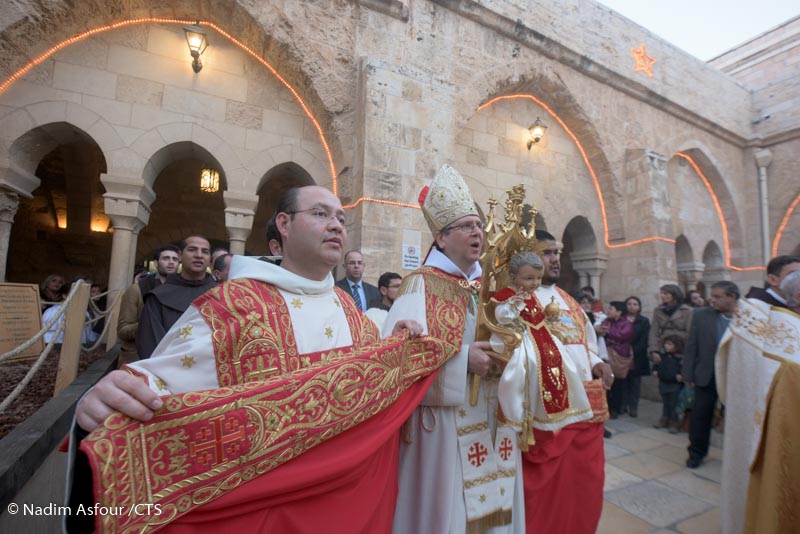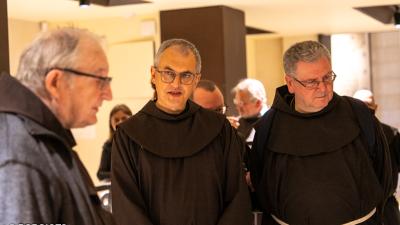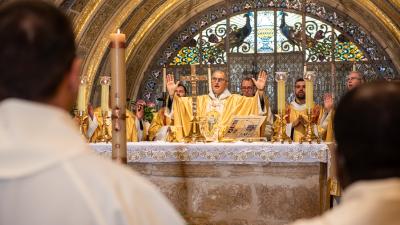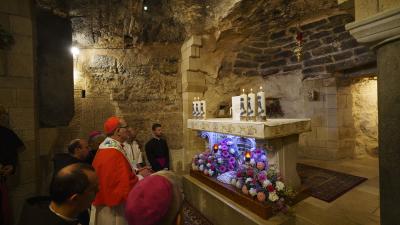
“The feast of the Epiphany is a very important holiday, because God is manifested to all peoples of the world and unites them,” said the Custos of the Holy Land, Fr. Francesco Patton, at the beginning of the celebration of the Epiphany. The feast began on January 5 with the greeting of the parishioners of St. Savior's parish in Jerusalem. Before Fr. Francesco, the Vicar, Br. Dobromir Jasztal and the secretary of the Custody, Br. David Grenier, there were many children and families. “We hope this Epiphany may bring peace and serenity to our hearts, our homes and our country,” said Br. Nerwan, the parish priest of Saint Savior's. “The Epiphany, the manifestation of Christ, means that we become God's children through baptism,” explained the Custos. “He pushes us to feel more and more a part of the same family of God and to feel that the Lord wants to create unity among us who have welcomed him.”
After a speech by the son of the Moukhtar, the head of the Latin community of Jerusalem, the Custos and the other friars left the monastery in Jerusalem for their usual automobile procession to Bethlehem. Like at the beginning of Advent, and like it was for Christmas, the stops took place at Mar Elyas, where the pastor of Beit Jala was present, as well as at the Tomb of Rachel, with the pastor of Beit Sahour. In Bethlehem, at Manger Square, a crowd of faithful awaited the Custos of the Holy Land for his solemn entry. Br. Artemio Vitores, the Guardian of the Fraternity of Bethlehem, welcomed the Custos to the Church of St. Catherine, where the first prayer songs were sung. After lunch, first Vespers and the Office of Readings took place, while the Custos traveled to visit some of the local communities.
The next day, on January 6, a solemn mass celebrated for the Epiphany, for which the reading of the Three Magi who came from afar to worship Jesus, bringing gold and frankincense and myrrh, was read. Br. Rami Asakrieh, pastor of St. Catherine's, gave the homily, but the mass was presided over by the Custos of the Holy Land. For Second Vespers at 3:30 p.m., Br. David Grenier, Br. Artemio Vitores, and Br. Sinisa Srebrenovic, donning red, green and gold vestments, and bearing gold, frankincense and myrrh, made their entry. A long procession went through the courtyard of the church of St. Catherine's to the sound of the Gloria in Excelsis Deo. “This is one of the most beautiful processions in Bethlehem," said two of the friars. After bringing the gifts to Jesus' grotto, the three friars of the Custody let people touch these gifts with their own hands and they distributed incense and myrrh to the faithful.
From the grotto, a festively dressed statue of the Child Jesus was carried in the procession. Jesus, the one whom, despite all of their differences, all Christians worship, can be seen by all on the feast of the Epiphany. According to Orthodox Churches' calendar, Christmas is celebrated on January 6. And so, at the Basilica of the Nativity, the various communities belonging to the Orthodox churches prayed First Vespers at the same time. Hearing the sounds of overlapping songs, the effect might have seemed a bit confusing, but it was not: it was the power of prayer and love for Jesus that everyone expressed through their own culture and tradition. “Here we can find everyone who welcomes Christ and that to me is part of the mystery that we celebrate today,” said Br. Stephane Milovitch.
Beatrice Guarrera
Epiphany and ecumenism in Bethlehem
Christmas in Bethlehem, where it all began
The Custody of the Holy Land received the well wishes of the Churches of Jerusalem




